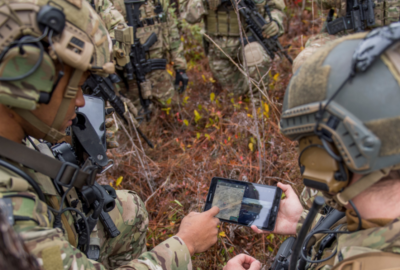
Pentagon sees JADC2 and new data strategy as inextricably linked
JADC2 is "at the heart" of the first-ever data strategy DoD published in October, according to the Pentagon official who led the strategy's development.
The Pentagon’s notion of Joint All-Domain Command and Control envisions a future battlefield where sensors from all of the military services — and all of their weapons systems — communicate with each other in one cohesive network. But getting there is going to be a journey, and DoD officials think their new data strategy will jumpstart the effort.
The strategy the department published in October aims to impose stronger governance over all of the military’s data, including information that’s used mainly for business purposes. But the first near-term objective the document mentions is to harness DoD data for “advantage on the battlefield,” in joint all-domain operations.
David Spirk, DoD’s recently-appointed chief data officer said the strategy was built with the concept of Joint All Domain Command and Control (JADC2) at top of mind, and that the DoD cross-functional team in charge of developing JADC2 has fully adopted the strategy’s goals.
“We’ve come to an agreement to bring the JADC2 data interoperability working group into one of our working groups under the DoD CDO Council,” he said. “When you lay the data strategy out and you really go to the principles inside of it, it’s about creating operational advantage and efficiencies. The operational advantage puts JADC2 right at the heart of the data strategy, and it was designed to be that way.”
It’s been nearly two decades since the last time the department developed something resembling a comprehensive data governance document. In 2003, DoD published the “Net Centric Data Strategy.” But Spirk said the department’s view of data has changed since then, and has evolved from an “outside-in” to an “inside-out” mindset.
“Previously, we focused on ensuring that there were networks and transports to send packages of information and data when and where it needed to go,” he said. “When we talk about inside-out, we’re really talking about putting the warfighter and senior leader who needs to make a better decision at the center of everything, and ensuring that the data can flow. The requirements flow from them to the portions of the machine that need to make their data available so it can be pulled back to the center, be aggregated, be analyzed, and render decisions in a faster manner at the speed of mission.”
The next step is for each of the military services to draw up implementation plans for the data strategy as the Army, Navy, Air Force and Marine Corps continue through the early stages of moving toward the department’s vision for JADC2. To do that, the Pentagon wants them to tweak their own data strategies so that each of them shares a common lexicon.
Dana Deasy, the Pentagon’s chief information officer, said building that sort of commonality will be especially important for technologies that JADC2 will depend on, like cloud computing and machine learning.
“Massive amounts of data have got to come together, and it just screams out of this constant conversation I keep having about the tactical cloud at the tactical edge,” Deasy said. “When I sit down with folks in the Joint Staff and the military services, inevitably, one of the conversations that tends to get the largest amount of energy is data. You’ve got all this data coming in, you’ve got to secure it in the right way, you’ve got to format it. And machine learning is a perfect application to take massive amounts of data and start to put intelligence behind it to say what of all that data that’s coming in is going to matter most to the commander in the field.”
Spirk said one of the end goals of the data strategy is to start treating the department’s collective data assets as a weapons system in and of itself. But to make real progress toward that goal, the military services’ physical, kinetic weapons systems will need to be meaningful participants in that ecosystem.
That’s a bit easier to pull off for the systems that will be built after the strategy’s publication. It’s much harder for the platforms DoD already owns — and will continue to operate — for decades to come.
“Let’s be realistic about expectations and timelines, because we still have legacy systems that were not designed to be machine extensible,” Spirk said. “We have legacy systems that potentially don’t comport to an open data standards architecture that is required to move forward. Moving forward, we’ll be acquiring things that do comport to those modern standards, but we’re still going to have some bolt-on fixes that we have in place for a while. We have some challenges, but we’re working iteratively to overcome them. I think that helps us plow into the JADC2 future that our senior-most commanders are expecting.”
Copyright © 2025 Federal News Network. All rights reserved. This website is not intended for users located within the European Economic Area.
Jared Serbu is deputy editor of Federal News Network and reports on the Defense Department’s contracting, legislative, workforce and IT issues.
Follow @jserbuWFED






